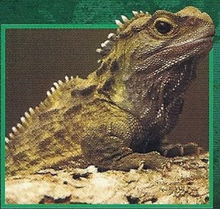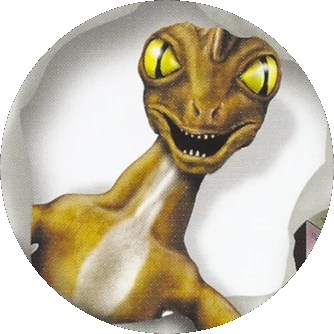The tuatara is known as "the living fossil." That's because the animal is a member of a reptile family that's been on Earth since before the reign of the dinosaurs. These creatures escaped the mass extinction that wiped the dinosaurs off the planet. Good defenses and a relaxed, slow-paced life have helped the tuataras survive for more than 200 million years. An individual tuatara can live for more than 100 years.
Look Ma, No Teeth: This reptile doesn't have real teeth, as do lizards. Instead the tuatara uses jagged extensions of its upper and lower jawbones to crunch up prey.
Good Defense: Adult tuataras have a ridge of small spines running along their backs. The creatures raise these spines and also open their bright-red mouths to startle enemies.
Survivor[]

The tuatara emerges from its burrow to look for a meal.
The tuatara is the last surviving member of an order of reptiles called Rhynchocephalia, which first appeared on Earth about 245 million years ago. The tuatara itself has survived almost unchanged for at least 220 million years, which means that the species walked the Earth before the dinosaurs. An unknown disaster, possibly a massive meteor strike, occurred 65 million years ago, which killed off the dinosaurs. Somehow the tuatara managed to live through the catastrophe and survive into modern times.
Slow Paced: This reptile leads a lazy lifestyle. It spends so little energy when it walks that it has to breathe only once every seven seconds. While at rest, it breathes once per minute. These creatures even grow slowly, taking up to 20 years to reach maturity.
Backstabber: Seabirds sometimes let tuataras visit their nests. The reptiles clear the nests of insects that are attracted by the birds' dung. While in a nest, the tuataras sometimes prove to be greedy guests and eat the birds' eggs as well.
Skull Show[]
- Scientists clearly see how long ago tuataras evolved by comparing their skulls to those of modern reptiles. Large openings behind the tuatara's eye sockets were also traits of the dinosaurs.
- The skull of a modern lizard has teeth that fit into sockets in the jaw. Also, openings in a lizard's lower jaw allow the reptiles to open wide and engulf larger prey.
- Tortoise skulls don't have openings behind the eyes. However, these more modern reptiles, like the tuatara, have jagged extensions in their jaws rather than real teeth.
Trivia[]
- The scientific names listed are the two species of Tuatara which share the same common name.
- The tuatara is shown on the back of the Giant Weta card, trying to eat one before the weta wards it off.
